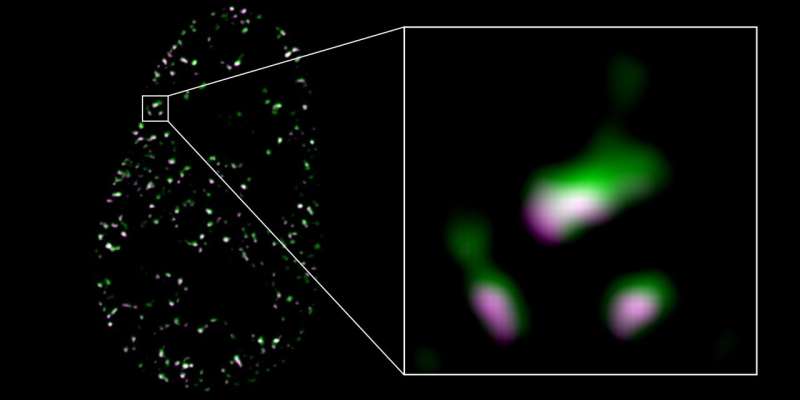
Researchers from Freiburg and Kiel discovered that actin acts in the cell nucleus and is partly responsible for the expression of male sexual characteristics
Steroid hormones, to which belong sex hormones like estrogen or testosterone, are important signaling molecules and are responsible among other things for controlling female and male phenotypic sex differentiation. They act by binding to receptor molecules that switch on and off the activity of hormone-dependent genes.
Researchers at the University of Freiburg and Kiel University Hospital have discovered that components of the cytoskeleton are critically involved in this process. The findings are relevant for the diagnosis of medical conditions and the study of diseases and cancers in which steroid hormones play important roles. The study was published in Nature.
The new research findings show that filamentous actin, a component of the cytoskeleton, interacts with the androgen receptor directly in the cell nucleus and strengthens its effect. The androgen receptor mediates the signals of sex hormones for male sex development but also promotes the progression of prostate cancer.
A genetic modification as the key indicator
Scientists with different research foci from Freiburg, Kiel, and Lübeck collaborated on the study across disciplines. The project was led jointly by Prof. Dr. Robert Grosse and PD Dr. Nadine Hornig: Grosse conducts his research at the Cluster of Excellence CIBSS—Centre for Integrative Biological Signalling Studies and the University of Freiburg’s Faculty of Medicine, Hornig at University of Kiel´s Faculty of Medicine and the University Hospital Schleswig-Holstein, campus Kiel.
The researchers became aware of the previously unknown connection between actin and steroid hormones while studying the cells of patients with a so-called androgen insensitivity syndrome (AIS). People who live with AIS have a set of male XY chromosomes but have less pronounced male sexual characteristics, extending even to a completely female appearance. This is often due to a change in the androgen receptor, which means that male sex hormones can no longer take effect. However, the androgen receptor is frequently unchanged in patients with AIS.
“We want to find out what genetic modifications cause AIS in these patients,” explains Hornig. “Thus, we wanted to identify further molecules that play a role in the development of sexual characteristics.” For this purpose, the researchers used a screening method to examine the cells of patients with AIS. In the process, they discovered mutations in the DAAM2 gene in two patients: The molecule belongs to the group of formins and controls the dynamic polymerization and elongation of actin filaments. As a part of the cytoskeleton, actin is important for the stability and locomotion of cells but also serves regulatory functions.
High-resolution microscopy reveals the processes in the cell nucleus
The researchers used high-resolution 3D SIM microscopy to examine whether DAAM2 is indeed important for the effect of sex hormones. This is an elaborate technique that can be used to observe molecular movements within cells. The images show that DAAM2 and actin colocalize with the androgen receptor directly in the cell nucleus. Further experiments demonstrated that this colocalization is important for the control of gene activity.
“This is a completely unknown mode of action, which we succeeded in describing here for a very important receptor,” says Grosse, highlighting the significance of the new findings. The research team assumes that the mechanism could be widespread and also influences the effect of other steroid hormones. “This could play a role in many physiological processes and diseases. It will be exciting to see whether it will enable new therapeutic approaches,” explains Grosse.
Diagnosis possible for more patients with AIS
The discovery also provides a basis for further research on the development of sexual characteristics and enables a clear diagnosis for more patients with AIS.
“Previously, patients with androgen insensitivity but without a modification in the androgen receptor did not receive a clear diagnosis despite having clear symptoms,” says Hornig. “Now we can make a clear diagnosis for those in whom DAAM2 is altered.”
More information:
Julian Knerr et al, Formin-mediated nuclear actin at androgen receptors promotes transcription, Nature (2023). DOI: 10.1038/s41586-023-05981-1
Journal information:
Nature
Source: Read Full Article
